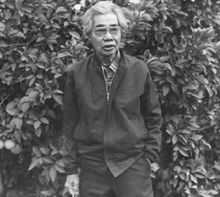Philip Vera Cruz

Philip Vera Cruz (December 25, 1904 – June 12, 1994) was a Filipino American labor leader, farmworker, and leader in the Asian American civil rights movement. He was a co-founder of the Agricultural Workers Organizing Committee, which later merged with the National Farm Workers Association to become the United Farm Workers. As the union's long-time vice president, he worked to improve the working conditions for migrant workers.[1]
Early life
Vera Cruz was born in Saoag, Ilocos Sur, the Philippines on December 25, 1904. As he grew older, he undertook some farm work there, which he described as much easier than the work he would do in California.[2] In 1926, Vera Cruz moved to the United States, where he performed a wide variety of jobs, including working in an Alaskan cannery, a restaurant, and a box factory.[3] He was briefly a member of the Industrial Workers of the World.[4]
Labor activities
Vera Cruz eventually settled in California, where he became a farmworker. He joined the AFL-CIO-affiliated union, the National Farm Labor Union, in the 1950s. His union local, based in Delano, California, had an Agricultural Workers Organizing Committee (AWOC). The prime focus of AWOC was to add members to the National Farm Labor Union. AWOC was composed primarily of Filipino American farmworker organizers, although it did hire Dolores Huerta. Huerta eventually quit the AWOC to join the National Farm Workers of America, which had a primarily Mexican American membership.[5]
Philip Vera Cruz, a former UFW Vice President, described the start of the great Delano grape strike. "On September 8, 1965, at the Filipino Hall at 1457 Glenwood St. in Delano, the Filipino members of AWOC held a mass meeting to discuss and decide whether to strike or to accept the reduced wages proposed by the growers. The decision was 'to strike" and it became one of the most significant and famous decisions ever made in the entire history of the farmworkers struggles in California. It was like an incendiary bomb, exploding out the strike message to the workers in the vineyards, telling them to have sit-ins in the labor camps, and set up picket lines at every grower's ranch… It was this strike that eventually made the UFW, the farmworkers movement, and Cesar Chavez famous worldwide."[5]
On September 8, 1965, the Delano local voted to strike against the grape growers. Following the strike call, the growers attempted to bring in Mexican American workers, some of whom were affiliated with the National Farm Workers of America. Cesar Chavez, Dolores Huerta, and other leaders of the National Farm Workers of America met with several National Farm Labor Union organizers, including Vera Cruz, Larry Itliong, Benjamin Gines and Pete Velasco. Together, they decided that both unions would strike against the grape growers, an action which eventually led to both unions joining to become the United Farm Workers.[6] The new union debuted in August 1966, and continued the strike into 1970.[7]
In the new union, Vera Cruz served as second vice president and on the managing board.[3]
Leaving the UFW and later life
Vera Cruz resigned from the UFW in 1977. That year, Cesar Chavez traveled to the Philippines to meet with Ferdinand Marcos, whom Vera Cruz saw as a brutal dictator.[8] Vera Cruz continued to live in the San Joaquin Valley of California after his resignation, and remained active in union and social justice issues for the rest of his life.[7] Vera Cruz received the Ninoy M. Aquino Award in 1987, traveling to the Philippines for the first time in fifty years to accept it.[9] In 1992, the AFL-CIO's Asia Pacific American Labor Committee honored Vera Cruz at its founding convention.[10] He died at the age of 89 in 1994, in Bakersfield, California.[11]
Legacy
In 2013, the New Haven Unified School District renamed Alvarado Middle School Itliong-Vera Cruz Middle School in honor of Vera Cruz and Larry Itliong; this school is the first school in the United States to be named after Filipino Americans.[12]
References
- ↑ Lyons, Richard D. (June 16, 1994). "Philip Vera Cruz, 89; Helped to Found Farm Worker Union". New York Times. pp. B9.
- ↑ Scharlin, Craig; Lilia Villanueva (2000). Philip Vera Cruz: A Personal History of Filipino Immigrants and the Farmworkers Movement. Seattle, Washington: University of Washington Press. p. 5. ISBN 0-295-97984-4.
- ↑ 3.0 3.1 Saito, Leland T. (1998). Race and Politics: Asian Americans, Latinos, and Whites in a Los Angeles Suburb. Champaign, Illinois: University of Illinois Press. p. 130. ISBN 0-252-06720-7.
- ↑ Le Blanc, Paul (1999). A Short History of the U.S. Working Class: From Colonial Times to the Twenty-First Century. Amherst, New York: Humanity Books. p. 64. ISBN 1-57392-664-7.
- ↑ 5.0 5.1 Scharlin, Craig; Lilia Villanueva (1998). The Fight in the Fields: Cesar Chavez and the Farmworkers Movement. Harvest/HBJ Books. p. 203. ISBN 0-295-97984-4.
- ↑ Article Index - INQUIRER.net
- ↑ 7.0 7.1 Shen Wu, Jean Yu-wen; Min Song (2000). Asian American Studies: A Reader. New Brunswick, New Jersey: Rutgers University Press. p. 190. ISBN 0-8135-2726-0.
- ↑ Ferriss, Susan; Ricardo Sandoval (2000). The Fight in the Fields: Cesar Chavez and the Farmworkers Movement. Orlando, Florida: Harvest Books/HBJ. p. 203. ISBN 0-15-600598-0.
- ↑ Sinnott, Susan (2003). Extraordinary Asian Americans and Pacific Islanders. New York, New York: Children's Press. p. 74. ISBN 0-516-29355-9.
- ↑ Aguilar-San Juan, Karen (1994). The State of Asian America: activism and resistance in the 1990s. Cambridge, Massachusetts: South End Press. p. 348.
- ↑ Richard D. Lyons (16 June 1994). "Philip Vera Cruz, 89; Helped to Found Farm Worker Union". The New York Times. Retrieved 17 March 2011.
- ↑ Chris De Benedetti (19 April 2013). "Union City school is nation's first named after Filipino-Americans, but acrimony over decision remains". Mercury News. Retrieved 5 May 2013.
External links
|